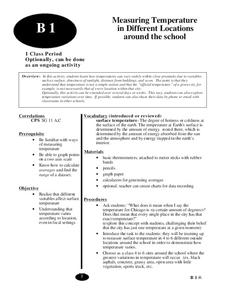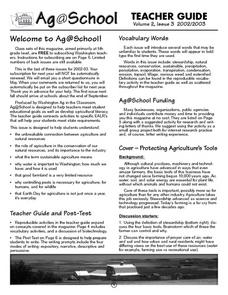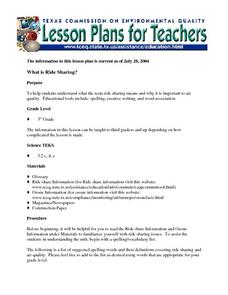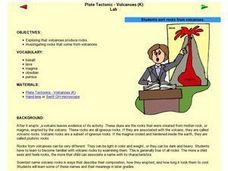Curated OER
Future Conditional
Pupils examine how toxic pollutants affect environmental and human health. They define key terms, watch a video, and answer discussion questions.
Curated OER
A Thoreau Look at Our Environment
Sixth graders write journal entries o school site at least once during each season, including sketched and written observations of present environment. They can use sample topographical maps and student's own maps. Students can use...
Curated OER
Scavenger Hunt
Young scholars study a research telescope to obtain quantitative information about these objects. They use the SkyServer Navigation Tool to identify objects and record celestial coordinates. In addition, they associate star brightness...
Curated OER
Biodiversity Bird Hunt
Learners examine the influence of biodiversity on human culture through the use of birds. They brainstorm words that come to mind when they think of human cultures. They describe ways that human culture and biodiversity are linked.
Curated OER
Organization of the Elements and Periodic Table
Students identify how to relate the position of an element in the periodic table to its atomic number and atomic mass. They also identify and interpret how to use the periodic table to identify metals, semimetals, nonmetals, and...
Curated OER
Measuring Temperature
Students explore the different variables that affect surface temperature. They study how temperatures can vary widely within close proximity due to variables such as surface, directness of sunlight, and distance from buildings.
Curated OER
Weather Predictions
Fourth graders explore meteorologists. They explore symbols on a weather map and make five day forecasts.
Curated OER
Creating and Analyzing Graphs of Tropospheric Ozone
Students create and analyze graphs using archived atmospheric data to compare the ozone levels of selected regions around the world.
Curated OER
What's The Level?
Students examine the movement of the water table and saturation zones. They describe the movements of the water table and locate the saturation zones. Students identify the function of each saturation zone. They develop a model of the...
Curated OER
Protecting Agriculture's Tools
Students brainstorm which tools farmers can control and why. They discuss how to conserve water, air and soil. They discuss the role of farmers and how they feed the world.
Curated OER
How to Be "Naturally Attractive" (Without Even Trying)
Students examine the various properties of magnets, explain how a compass works and make an electromagnet. They also experiment with magnetic lines-of-force using paper and iron filings.
Curated OER
Types of Legs
Students identify the characteristics of the legs of arthropods as well as how they are used. They compare and contrast the legs of various types of bugs in the arthropod family. A comparison worksheet is included in with this lesson.
Curated OER
The Excursion
Students throw dice and make their way around a board, answering questions, performing tasks and finding out about the environment as they go.
Curated OER
Cloud Shadows
Students classify the visual opacity of various materials, what is needed to create shadows, and classify clouds by the types of shadows that they produce.
Curated OER
Rollin' On
Third graders investigate the effects of gravity on the motion of a marble on an inclined plane and a declined plane. They work in small cooperative groups to predict and explain outcomes.
Curated OER
Weather Myths
Fourth graders examine myths that are based on weather phenomenon. They write, illustrate and present an original weather myth.
Curated OER
Spinning the Eco Web
Students examine the components and relationships of ecoregions and ecosystem management. They define ecoregion and ecosystem, list ecoregions, and participate in a simulation that demonstrates the connections between parts of the...
Curated OER
What is Ride Sharing?
Third graders discover the concept of ride sharing. They discuss how it helps the environment. They use the internet to gather information as well.
Curated OER
Deserts KWL Chart
Students will define what a desert is through the creation of a KWL Chart. This will help students to tap prior knowledge and make new connections with the new curriculum being delivered in the lesson.
Curated OER
Sunlight and Heat
Learners brainstorm about the sources of heat. They discuss that sunlight is one of those sources. Students complete a lab about cold water and warm water. They record the temperatures from each thermometer and discuss which container...
Curated OER
RIDE THE WILD LEAF
Students identify and interpret that leaves provide food for new trees and plants. Students cut out leaves and glue them on the appropriate
number on included worksheet. Students collect different types of leaves and make leaf rubbings....
Curated OER
Planet/Constellation Mobile
Pupils, through small group discussion, identify and share a rationale for shapes and patterns in the construction of a mobile that represents the solar system that makes them think of the creation of our solar system.
Curated OER
Would You Drink This?
Students examine how they affect water quality of those who live downstream after identifying rivers and river basins in Kansas.

























